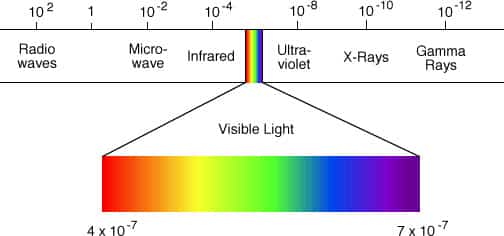Light Reactions:
– require chlorophyll and take place in thykaloid membranes
– absorb light energy and transfer it to ADP and NADP+
– energy is transferred to carbohydrate molecules in the Calvin cycle
Carbon Fixation:
– incorporate molecules of CO2(g) into organic molecules, such as glucose
– require energy from ATP and NADPH
– takes place in the stoma by means of the Calvin cycle
Light (Electromagnetic (EM) radiation:
– is a form of energy that travels as photons
– photons are wave packets characterized by their wavelength and energy
– photons with short wavelengths have high energy and photons with long wavelengths have low energy
Electromagnetic Spectrum:
– Sun light is a mixture of photons of different energies
– photons of different energies can be separated when passed through a transparent prism in a spectroscope forming the electromagnetic spectrum
– humans can see light between 380nm (violet)-750nm(red), but the rest is invisible
– thylakoid membranes have clusters of photosynthetic pigments, called photosystems, that absorb photons
Chlorophyll
Chlorophyll a and b:
– absorb photons in the blue-violet and red regions of the spectrum
– reflect photons in the green region of the spectrum
– chlorophyll a is the only pigment that can transfer light energy to the carbon fixation reactions
– cholorphyl b acts as an accessory pigment, absorbing photons that chlorophyll a absorbs poorly or not at all
Accessory Pigments
– transfer their energy to chlorophyll a
– chlorophyll a and b combined with accessory pigments, absorb light within the entire visible spectrum
Carotenoids:
– able to absorb light energy in the range from 400nm to 500nm
Plant carotenoids:
-some carotenoids absorb light which would otherwise damage chlorophyll, and then they lose light as heat
Human carotenoids
– similar compounds to plant cartenoids are thought to protect the eye from excessive photon damage
– b-carotene is converted to rhodopsin, a photopigment in the eye that helps vertebrates see in low-light conditions
– carrots are rich in b-carotene help maintain good vision
Leaf Colour:
– leaves appear green because of the high concentration of chlorophyll in the chloroplasts of leaf cells
– leaves appear different colours in autumn as plants stop producing chlorophyll and disassemble those already in the leaves; causes the yellow (xanthophylls), red (carotenoids) and brown pigments to become visible



Just to note that the wavelength numbers on the spectrum diagram are the wrong way round – blue should be 400 nm and red 700 nm
Great picture and explanation. Keep up the good work
HELLO,THANK YOU VERY MUCH,PLEASE SEND ME Photosynthetic cycle.